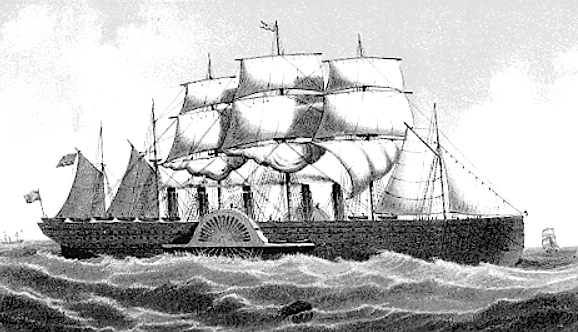This is the famous photograph of Isambard Kingdom Brunel, the world-renowned British engineer who revolutionized both the railroad and shipping industries. He achieved many firsts in engineering including the design of the SS Great Eastern, by far the largest steamship ever built at the time of her launch in 1858.

The photograph shows him smoking a cigar, the epitome of Victorian style with a top hat and vest standing in front of the launching chains of the Great Eastern. The photograph was taken by Robert Howlett in 1857 two years before his death. Brunel affectionately called his greatest creation the “Great Babe”. Sadly, Brunel collapsed from a stroke before the ship’s maiden voyage and never lived to see his creation sail. When the Great Eastern was launched she was the heaviest object ever moved by man.
The Great Eastern was built at the Millwall Iron Works by John Scott Russell & Co. on the Thames River in London. She was powered by side wheels, a screw propeller, and sails. She could carry 4,000 passengers from England to Australia without refueling. Her length of 692 feet was only surpassed 40 years later in 1899 by the 705-foot RMS Oceanic and her displacement of 18,915 tons was surpassed 42 years later by the 20,904-ton RMS Celtic. She was four times the size of the average steamship, but she turned out to be a white elephant, never achieving real success.
Isambard Kingdom Brunel was a child prodigy born on April 9th, 1806 in Portsmouth, England. His name came from his father, Sir Marc Isambard Brunel, a French civil engineer and his middle name from his mother, Sophia Kingdom. Bruel learned geometry by the age of 8 and spoke French and English fluently before the age of 13.
Brunel had a successful career designing many bridges and railways in England, many still in use today. He designed several steamships, the first was the Great Western launched in 1837. She was the largest steamship in the world at 234 feet and 2300 gross tons displacement. She made 45 voyages across the Atlantic carrying passengers and mail and later served as a troop carrier during the Crimean War.
Four years later Brunel designed the SS Great Britain. She was the first steamship built of iron to use a propeller for propulsion and is considered by many to be the first ocean liner. The Grat Britain is preserved as a museum ship in Bristol, England.
In 1852 legend has it that Brunel sketched the idea for the Great Eastern on a napkin. He envisioned a grand ship that would be five funneled with seven masts, powered by paddle wheels, a propeller, and sail. She would have a double hull and double keel and have the ability to sail halfway around the world non-stop,
The construction of the ship ran into many difficulties and ran over budget, bankrupting her investors. There were a series of accidents during construction with six workers being killed. There were also rumors of a phantom riveter who had been trapped and sealed in the hull. The hull was an all-iron construction made up of roughly 30,000 iron plates. They were cut individually over wooden templates before being rolled to the required curvature. The Great Eastern was the first ship to incorporate a double-skinned hull, a feature that would not be seen again in a ship for 100 years. To maximize her fuel capacity coal was bunkered around and over her ten boilers. The paddle wheels were 55 feet in diameter and the 4-bladed screw-propeller was 23 feet across. The power came from four steam engines for the paddles and an additional engine for the propeller, totaling 8,000 hp. She had six masts carrying 18,150 square feet of sail. However, the sails were unusable with the engines because the hot exhaust from the four funnels would set them on fire. Her maximum speed was 13 knots.
The Great Eastern was first employed as a transatlantic liner but was a victim of its own size as smaller vessels were faster. The ship managed to provide a small profit for its owners until disaster struck in September 1861 when she was hit by a hurricane and needed extensive repairs. In August 1862 she ran aground off the U.S. coast and was unable to meet the recovery costs. The Great Eastern was put up for auction in 1864. From 1865 until 1873 the Great Eastern finally found her niche as a cable-laying vessel and in 1886 lay the first cross-Atlantic telegraph cable which stretched from Ireland to Newfoundland. The ship was ideally suited to this type of work because her great size allowed her to carry the massive rolls of cable. The Great Eastern went on to lay cables from England to France and India.
The Great Eastern retired from cable laying and sat at a dock for 12 years before being used as a floating dance hall on the River Mersey. The ex-liner, Brunel’s dream, once the largest ship in the world, was sold for scrap in 1889. It took almost two years to demolish the enormous ship. No trace of the phantom riveter was ever found.
